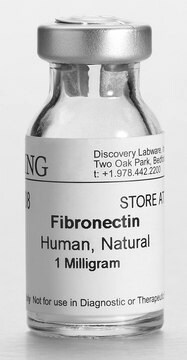F1056
Human Fibronectin
from human plasma, powder, suitable for cell culture
Sinónimos:
Fibronectin
About This Item
Productos recomendados
product name
Fibronectina, lyophilized powder, BioReagent, suitable for cell culture, ≥95% (SDS-PAGE)
biological source
human plasma
Quality Level
sterility
sterile
product line
BioReagent
assay
≥95% (SDS-PAGE)
form
lyophilized powder
packaging
pkg of 1 mg
pkg of 2 mg
pkg of 5 mg
technique(s)
cell culture | mammalian: suitable
surface coverage
1‑5 μg/cm2
solubility
H2O: 1 mg/mL at 37 °C
UniProt accession no.
binding specificity
Peptide Source: Collagen
shipped in
dry ice
storage temp.
−20°C
Gene Information
human ... FN1(2335)
¿Está buscando productos similares? Visita Guía de comparación de productos
General description
Application
- in neural selection medium to coat tissue culture surface for neuronal differentiation
- to coat culture vessels for characterization of iPSC and iPSC‑derived BMEC in 2D cell culture
- to coat culture supports for endothelial cell culture
Biochem/physiol Actions
Caution
Preparation Note
In coating culture surfaces, fibronectin should be diluted in sterile balanced sterile salt solution and coated with minimal volume. Surface should then be air dried for 45 minutes at room temp and can be stored for 2-4 weeks at 2-8°C.
Disclaimer
Storage Class
11 - Combustible Solids
wgk_germany
WGK 3
flash_point_f
Not applicable
flash_point_c
Not applicable
ppe
Eyeshields, Gloves, type N95 (US)
Certificados de análisis (COA)
Busque Certificados de análisis (COA) introduciendo el número de lote del producto. Los números de lote se encuentran en la etiqueta del producto después de las palabras «Lot» o «Batch»
¿Ya tiene este producto?
Encuentre la documentación para los productos que ha comprado recientemente en la Biblioteca de documentos.
Los clientes también vieron
Artículos
Extracellular matrix proteins such as laminin, collagen, and fibronectin can be used as cell attachment substrates in cell culture.
Protocolos
Dilute fibronectin to the desired concentration. Optimum conditions for attachment are dependent on cell type and application. The typical coating concentration is 1 – 5 ug/cm2.Fibronectin coating protocol, products, and FAQs.
Nuestro equipo de científicos tiene experiencia en todas las áreas de investigación: Ciencias de la vida, Ciencia de los materiales, Síntesis química, Cromatografía, Analítica y muchas otras.
Póngase en contacto con el Servicio técnico






